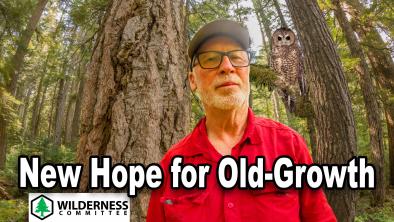Can't See The Forest For The Gump
The Valley Voice
Owl country facing loggers axe
The endangered spotted owls don’t know it yet, but they are in for a bumpy ride if a local company proceeds with plans to log in the upper reaches of the Chilliwack River Valley (CRV) near Post Creek.
The insatiable need for natural resources once again is pitting residents and environmental groups against business interests in the CRV. During the last schism, it was gravel vs. residents. This time, it’s logging vs. species-at-risk.
Three-years ago, Tamihi Logging Company made applications with the BC Ministry of Environment to obtain cut-blocks at Post Creek which they had previously staked, before it was designated owl habitat by the BC Ministry of Environment.
After pressure from Tamihi, the BC Ministry of Environment, mollified its original position, and overruled their 2006 Wildlife Habitat Area (WHA) designation in order to allow loggers access to about 140 hectares where they could cherry pick from thirteen cut-blocks in the ancient stands.
This goes against the grain with environmentalists, who say that cutting down trees in the area puts the owl at greater risk, and that more work needs to be done to preserve their environment instead of destroying it.
Glen Thompson, who is a tireless crusader and environmental activist in the CRV, as a resident, fought long and hard against the Tolmie gravel pit and has since moved to New Westminster. But that doesn’t mean he suddenly stopped caring about the area. He still drives in to Chilliwack whenever there’s a need to help out on local environmental or community issue.
Thompson said that Penner made the decision not to go ahead with the environmental assessment of the gravel mine impact and he wants to know if the environment minister's logic was backed by science, or economics.
After the CRV gravel mine decision, Thompson sees the Ministry of Environment’s deck as being stacked against the environment and last week he was at Chilliwack-Hope MLA Barry Penner’s office on Vedder Rd. to ask for information pertaining to the minister’s decision which helped facilitate gravel mining there.
“We are going to ask Mr. Penner if he can provide us with the staff recommendations on the environmental assessment that was done for the open pit mine in the Chilliwack River Valley,” Thompson told the Voice. “We’d like to see if that’s backed-up by the staff report or not.”
Thompson added they would also ask Penner to characterize his negotiations with Tamahi.
Regarding the spotted owl, Thompson says the MOE protection exemption orders that allow Tamihi to log within a habitat zone need to be rescinded.
He also wants and independent inquiry to look at the decision-making processes behind the gravel and logging determinations made through an and whether
“We’d like some type of judicial review to take place, to look at these things – are they being done in a legal manner; where are the documents and how they justify logging in a protected habitat."
"People like me, shouldn’t be protecting species, he’s got a whole staff of biologists, why is it left to normal local citizens to be up to speed on, how is this legal or how to protect them properly?” asked Thompson incredulously. “If we have to go and find the science ourselves, we will, but, it’s really his job, we’re just asking him to do his job.”
“This whole thing started with a federal court case when all the environmentalists agreed ‘let’s make a federal court case and try to save this owl and the province jumped up and said ‘you don’t need to go to the feds, we will protect the habitat.”
“We said, okay, we want these areas, and they said ‘we’ll grant you those areas as protected habitat', and now legally, they’ve gone behind the scenes and are logging the best trees – it just doesn’t make any sense, its crazy,” Thompson told the Voice.
It was also at Penner’s office that Thompson met with Burnaby-New West MP Peter Julian, who together, along with media went to Post Creek to tour the area.
“These areas are spotted owl areas,” said Julian pointing to the map. “In the past, they’ve logged some in all of them and what they’ve recently done is in the red areas, you get to log more in those, and the green areas they said there’d be no logging in.”
He referred to the thirteen areas to be logged as “grandfathered cut blocks” because they had already been pre-approved prior to 2006.
When the provincial government designated the area WHA, and the licences to log there were revoked, they assured logging companies there would be no impact on their earnings and to compensate, allowed more logging in other areas. But Tamihi Logging Co. complained saying they were affected so they were given the additional unlogged cut blocks.
“The owl numbers are going down so we’ve got to bite the bullet. There’s too much logging in this area and we’ve got to set aside some forest,” said Julian.
When asked about the fate of the owl if and when logging goes ahead, Julian said that it was too early to say.
“We’re not entirely sure they can survive. There needs to be measures put into place by the federal government and the provincial government but I think that there’s no doubt that it puts the species at profound risk when there’s only a few owls left in that valley.”
They have to move fast. Logging could begin as early as this spring.


